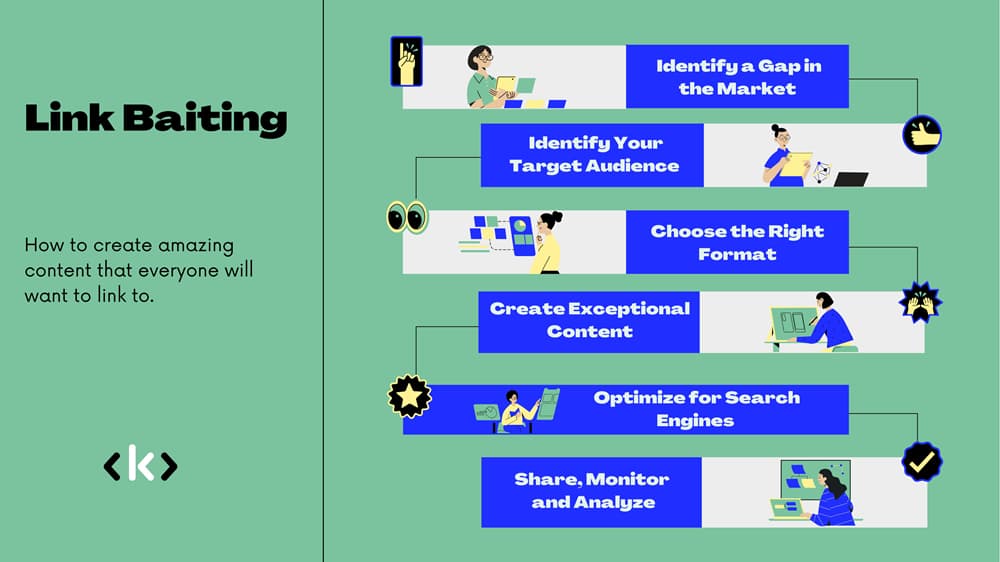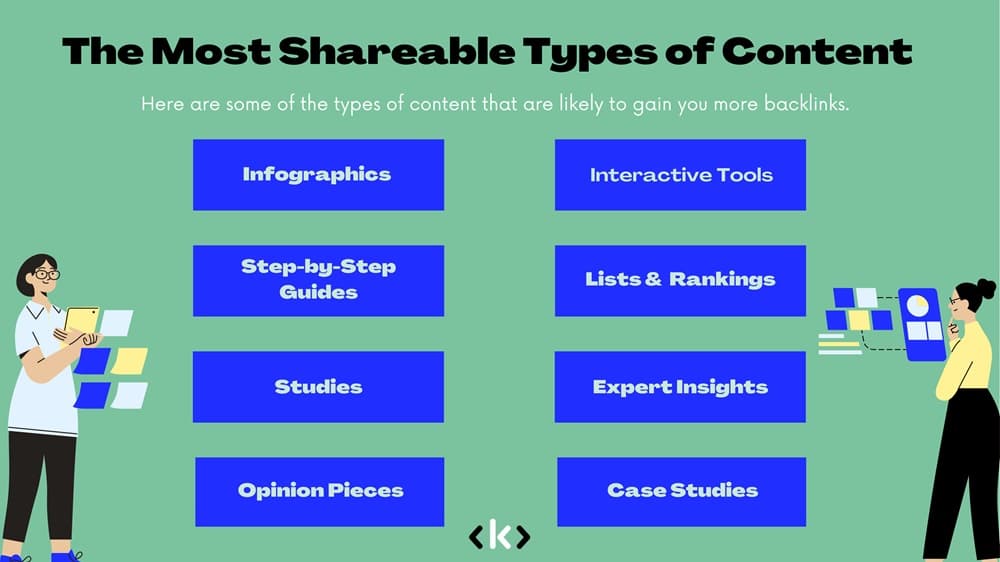- SEO
SEO Agency
Take advantage of the first traffic acquisition lever by entrusting your SEO to a digital agency experienced in SEO. - SEA
SEA Agency
Grow your business quickly with paid search (SEA).
- Social Ads
Social ads
Optimize your social media advertising campaigns to improve your performance. - Agency
The agency
Keyweo was born from the desire to create an agency that meets the principles of transparency, trust, experience and performance. - Blog
- Contact
Linkbaiting
Home > SEO Agency > SEO Glossary > Link Baiting
Definition
Link baiting involves creating high-quality, valuable content to attract inbound links from other websites. Compelling and naturally engaging content will gain links without the need for outreach.
Link bait is one of the best white-hat techniques to improve your site’s SEO performance. A high number of quality backlinks often contribute to a higher ranking in search engine results pages (SERPs). It is a sign that you provide trustworthy and relevant information, increasing your authority.
What is Link Baiting?
Link baiting is not just content creation. Not all content is created to gain links. The primary aim of link baiting is to generate backlinks organically . It should be compelling, unique, or useful so that other websites will want to link to it.
For example, promotional content aims to drive conversions and transactional content aids the sales process. These types of content are not produced to gain links, but rather to provide information and improve the user experience (UX).
But, an exceptional article or blog post with infographics or a research study is different. If a page has something distinctive to offer, it can garner respect and backlinks from webmasters. Below you will find further examples of link-baiting content.

Why is Link Baiting Important for SEO?
To grasp the significance of link baiting for SEO, it’s essential to understand the following concepts:
Google Core Ranking Factor
Google employs various ranking systems that assess different core factors to enhance the indexation process and deliver the most relevant and useful search results.
Backlinking is a crucial element of Google’s core ranking systems. Since its inception, one of the key systems Google uses is PageRank, which evaluates the relevance and authority of a page based on its backlinks. These backlinks act as endorsements from other websites. Google knows that the linked content is valuable and trustworthy.
In Google Search Central, you will find a complete guide to the different ranking systems.
Domain authority
Domain Authority is a metric to estimate a website’s chance of ranking well in the SERP. It’s a sign of credibility and trust. Sites are scored on a scale from 1 to 100. The higher the score, the higher the likelihood that the website will rank well.
Quality backlinks from reputable sites signal to search engines that your website has valuable content. As a result, they contribute to a higher domain authority score.
Role of link baiting in SEO
Backlinking, a core ranking factor, directly influences how Google evaluates and ranks your content. By attracting high-quality backlinks through effective link baiting, you can significantly boost your site’s Domain Authority, enhancing its credibility and potential for higher rankings.
What is the Difference between Link Baiting and Link Building?
Both link baiting and link building are strategies to gain inbound links to your site, but there is a key distinction between them.
Link baiting:
By creating elite content, other sites will naturally link to yours. This is passive and relies heavily on the quality of your work. The downside to link baiting is that we do not have control over who links and how it is done.
Link building:
Conversely, link-building is an active process. It involves seeking opportunities to acquire backlinks from others through outreach and networking. This approach allows you to be more selective over where and how back-links are obtained.
While both strategies can bring SEO benefits, it is important to understand the differences. Link baiting requires a lot of effort in creating the content but can have long-term benefits. Whereas link-building demands a lot of time invested in outreach.
What are the Different Types of Link Baiting?
The key to crafting content that webmasters are eager to share lies in focusing on high-quality and innovative material. Here are some examples that naturally attract links:
Infographics:
Infographics are an excellent tool for link baiting because they present information in a compelling and visually pleasing way that captures attention. A study by Springer demonstrates that people follow directions 323% better when they include illustrations, highlighting the power of visual aids.
Infographics are easy to share, thanks to their appealing design and ability to condense complex information into digestible visuals. This shareability extends across various platforms and languages, broadening their reach and impact.
Additionally, infographics enhance SEO rankings by increasing engagement, dwell time, and the likelihood of earning backlinks from other sites, which recognize the value of well-designed and informative content.
Tips for infographics:
- Incorporate clear, concise, and well-researched data. Your infographic should provide real value, encouraging users to share it.
- Include descriptive alt text for each image element within the infographic. This not only makes your content accessible to visually impaired users but also helps improve your SEO.
- Optimize the infographic for mobile viewing, since a significant portion of users will access it on their phones or tablets.
- Use your brand colors consistently to reinforce brand identity and make the infographic more recognizable.

Step-by-step guides:
Step-by-step guides are in-depth, thorough resources that provide detailed instructions on how to complete specific tasks or achieve particular goals. These guides can cover a wide range of topics, from DIY home improvement projects and cooking recipes to software tutorials and fitness routines. By breaking down complex processes into manageable steps, they make challenging tasks more approachable and achievable for readers.
Step-by-step guides are particularly effective because they offer substantial value to users. For example, Keyweo’s Screaming Frog SEO Guide has detailed advice on how to master the site audit tool. When people find a guide that helps them solve a problem or learn a new skill, they are likely to share it with others and link back to it from their websites or social media profiles.
This increases the guide’s visibility and authority, driving traffic and improving SEO rankings.
Studies:
Studies are highly effective for link baiting because they provide valuable information, that is not readily available elsewhere. By presenting fresh, data-driven insights, studies attract attention from other websites and bloggers looking to enhance their content with authoritative sources. This credibility and exclusivity make it more likely that other content creators will reference and link to your study, which boosts your site’s visibility and authority.
Furthermore, studies often come with visually appealing elements like charts and infographics, increasing their shareability and engagement. The data-driven nature of studies fosters ongoing discussions and debates, leading to additional backlinks and social media mentions over time. Although conducting a study requires considerable effort and resources, the long-term benefits of driving traffic and gaining valuable backlinks make it a worthwhile investment.
Opinion pieces:
Opinion pieces can also be highly effective for link baiting. Typically, they provide a unique perspective or commentary on current trends, controversies, or industry developments, which can resonate strongly with readers. When well-crafted, these pieces can stimulate conversation and debate, encouraging other websites and bloggers to link back to them as they reference or critique the viewpoints presented.
They are effective for link baiting because they frequently tap into trending topics or gaps in existing discourse, making them highly relevant and shareable. Use Google Trends or BuzzSumo to find subjects that are currently being searched for. Their subjective nature allows for a personal and engaging tone, which can attract a wide audience. By presenting a strong, well-articulated viewpoint, these pieces can stimulate conversation and debate, leading other sites and bloggers to reference or link back to them as they engage with or critique the opinions shared.
Interactive tools:
Interactive tools are excellent as they offer a highly engaging and personalized user experience that encourages sharing and repeat visits. Tools like calculators, quizzes, and interactive maps provide immediate, tangible value by allowing users to input their data or preferences and receive customized results. This level of interactivity not only captures attention but also increases the likelihood that users will share the tool with others who might find it equally useful or entertaining.
Moreover, interactive tools often have a longer lifespan, as they can remain relevant and useful over time. Their practical utility makes them a go-to resource that other websites, bloggers, and influencers are likely to reference and link to in their content. Moz, for example, offers numerous free tools which can be useful for SEO.
This continual engagement can lead to a steady stream of backlinks and sustained traffic, making the initial investment in creating an interactive tool well worth the effort.
Lists and rankings:
Lists and rankings are great because they condense complex information into easily digestible formats, making them highly shareable and appealing to a broad audience. Readers love these types of content because they provide quick, straightforward answers to common questions or offer a clear hierarchy of options or opinions. The structured format is not only easy to read, but also encourages others to link back as a reference or use it in their content, especially when it reflects a definitive or well-researched stance on a popular topic.
Expert insights:
Expert insights are valuable for link baiting as they leverage the credibility and authority of industry leaders or professionals. When a piece includes opinions or advice from recognized experts, it adds significant weight and trustworthiness, making it more likely to be cited by others. Readers and other content creators often seek out expert insights to support their arguments or to provide authoritative information to their audience, which leads to more backlinks and shares.
Case studies:
Case studies are powerful tools for link baiting because they provide in-depth, real-world examples that demonstrate the effectiveness of a product, service, or strategy. By offering detailed analysis and tangible results, case studies build trust and credibility, making them a valuable resource for others to reference. Content creators, especially in B2B industries, usually link to case studies to bolster their arguments or to provide evidence of successful practices, ensuring that these detailed accounts continue to attract traffic and backlinks over time.

What are the Best Link Baiting Strategies?
To effectively approach link baiting, focus on creating content that others will naturally want to share and reference. Here’s a strategic approach:
- Research Interests and Pain Points: Start by deeply understanding what your target audience cares about. Identify their interests, common challenges, and the type of content they engage with. This will help you create content that resonates with them and is more likely to be shared.
- Analyze Competitors: Look at what types of content are performing well for your competitors. Identify gaps or opportunities with tools like Thruuu. Determine where you can offer something better or different.
- Gather In-Depth Knowledge: Before creating content, invest time in thorough research. This involves not only understanding the topic deeply but also identifying the latest trends, statistics, and discussions in your niche. Well-researched content stands out as authoritative and credible, making it more likely to attract links from other content creators looking to reference accurate and up-to-date information. Use Google and tools like SEMRush to find the best keywords.
- Focus on Quality: Quality is key. Whether it’s original research, a comprehensive guide, or an interactive tool, ensure that your content offers substantial value. This increases the likelihood that others will see it as a valuable resource worth linking to.
- Make It Unique: Offer a fresh perspective or unique data that can’t be found elsewhere. Originality makes your content stand out and encourages others to cite it as a credible source.
- Choose the Right Format: Some formats naturally attract more links, such as in-depth articles, infographics, and expert roundups. Decide on the format that best suits your content and audience. Canva offers brilliant templates to create interesting and personalized designs easily.
- Optimize for Engagement: Incorporate elements that encourage interaction, such as quizzes, polls, or comment sections. Engaged users are more likely to share your content, increasing its reach and potential for backlinks.
Once your content is live, share it across relevant social media platforms, online communities, and forums where your target audience is active. This can help your content gain traction and attract organic links.

What Should You Avoid When Creating Link Bait?
When creating content for link bait, it’s important to avoid certain pitfalls that can undermine your efforts and damage your credibility. Here are key things to avoid:
- Clickbait Titles: While catchy titles might attract initial clicks, if the content doesn’t deliver on the promise, it can lead to high bounce rates, loss of trust, and negative engagement. This can harm your reputation and reduce the likelihood of earning backlinks.
- Low-quality content: Content that lacks depth or is poorly written won’t engage readers and is unlikely to be shared or linked to. Focus on providing real value and insights, as low-quality content can harm your brand and deter potential linkers.
- Misleading or Manipulative Information: Spreading misinformation or manipulating data to create sensational content can backfire, leading to loss of credibility and trust. It can also result in negative publicity, which could harm your brand and make others hesitant to link to your content.
- Duplicating Existing Content: Simply rehashing what’s already out there doesn’t add value and won’t give others a reason to link to you. Aim to provide fresh perspectives or new insights that distinguish your content from the rest.
- Ignoring User Experience (UX): If your content is hard to navigate, cluttered with ads, or lacks a responsive design, it can frustrate visitors and discourage them from engaging or sharing. Ensure your content is user-friendly and provides a seamless experience.
- Neglecting SEO Best Practices: Even the best content can go unnoticed if it’s not optimized for search engines. Ignoring SEO practices like proper keyword usage, meta tags, and internal linking can limit the visibility of your content, reducing its link-building potential.
What Tools Can You Use to Measure Link Baiting?
Analytics and Tracking Tools
Google Analytics:
Tracks traffic, engagement metrics, and referral sources, helping you measure the effectiveness of your link baiting efforts by showing where your traffic and backlinks are coming from.
Google Search Console:
Monitors your website’s performance in search results, tracks backlinks, and identifies which content is generating the most links.
Ahrefs and SEMrush:
Besides keyword research, these tools also track the number and quality of backlinks your content receives, allowing you to measure the success of your link baiting campaigns.
Measuring the Effectiveness of Link Baiting
Backlink Quantity and Quality
- Number of Backlinks: Track the total number of backlinks your content generates. Tools like Ahrefs and SEMrush can show you how many links you’ve earned and where they’re coming from.
- Domain Authority (DA): Measure the authority of the domains linking to your content. High-quality backlinks from reputable sites are more valuable than many low-quality links.
Traffic Metrics
- Referral Traffic: Use Google Analytics to monitor the amount of traffic coming from sites that have linked to your content. This helps you gauge the direct impact of your link baiting on-site visits.
- Organic Traffic: An increase in organic traffic after a successful link-baiting campaign can indicate that the content is performing well in search engines, thanks to the acquired backlinks.
Engagement Metrics
- Social Shares and Mentions: Track how often your content is shared or mentioned on social media. Tools like Buffer, Hootsuite, and BuzzSumo can help you measure social engagement.
- Time on Page and Bounce Rate: Analyze how users interact with your content. High engagement (e.g., long time on page, low bounce rate) indicates that the content resonates with the audience, making it more likely to attract links.
SERP (Search Engine Results Pages) Performance
- Keyword Rankings: Monitor the rankings of target keywords associated with your content. Improved rankings can be a result of successful link baiting that enhances your content’s authority and relevance.
- Click-Through Rate (CTR): Higher CTR in search results can indicate that your link baiting efforts are making your content more appealing to users.
By utilizing these tools and monitoring these metrics, you can refine your link baiting strategies and continuously improve the effectiveness of your campaigns.
Conclusion
Link baiting is a technique used by SEO experts to get other websites to link to their site. These backlinks prove to Google that the site is valuable, creditable, and trustworthy. The quantity and quality of backlinks is an important ranking factor for Google.
The goal is to create high-quality, unique, SEO-friendly content to catch the eye of webmasters. By following SEO best practices and investing time in the creation, you can create a page that naturally attracts links from other websites.
This content should provide significant value, whether through original research, compelling storytelling, interactive tools, or expert insights. The more beneficial your content is, the more likely it is to be shared and referenced by others.
Consistent efforts in link baiting can not only improve your site’s visibility in search engine results but also establish your site as a reputable source within your industry. Maximize the impact of your link baiting efforts, ultimately boosting your website’s authority and rankings on Google.
The most popular definitions
Web Accessibilty
Google algorithm
Crawler
Google EAT
Google Search Console
Crawl Budget
Google Pagerank
Voice search
URL
Google Penguin
Google filter
Search engine
Boost your Visibility
Do not hesitate to contact us for a free personalised quote
Notez ce page







